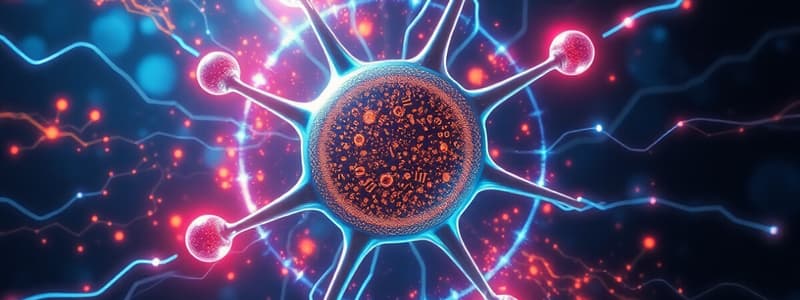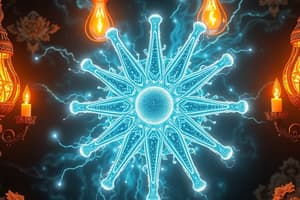Podcast
Questions and Answers
Which of the following particles have approximately the same relative mass?
Which of the following particles have approximately the same relative mass?
A negative terminal is the point with a higher electrical potential than a positive terminal.
A negative terminal is the point with a higher electrical potential than a positive terminal.
False (B)
What happens when there is a connection between the live wire and earth?
What happens when there is a connection between the live wire and earth?
What is the name of the instrument used to measure potential difference in a circuit?
What is the name of the instrument used to measure potential difference in a circuit?
Signup and view all the answers
In a ______ circuit, components are connected in separate branches, allowing current to flow along different paths.
In a ______ circuit, components are connected in separate branches, allowing current to flow along different paths.
Signup and view all the answers
Switches and fuses should be connected in the neutral wire of a domestic circuit to ensure safety.
Switches and fuses should be connected in the neutral wire of a domestic circuit to ensure safety.
Signup and view all the answers
What is the purpose of an earth wire?
What is the purpose of an earth wire?
Signup and view all the answers
Match the electrical term with its correct definition:
Match the electrical term with its correct definition:
Signup and view all the answers
What best describes the flow of electrons in a circuit?
What best describes the flow of electrons in a circuit?
Signup and view all the answers
A fuse is designed to _____ when too much current flows through it.
A fuse is designed to _____ when too much current flows through it.
Signup and view all the answers
At a junction in a circuit, the total current entering the junction is always less than the total current leaving it.
At a junction in a circuit, the total current entering the junction is always less than the total current leaving it.
Signup and view all the answers
Match the following safety devices with their function:
Match the following safety devices with their function:
Signup and view all the answers
Which formula correctly relates potential difference (V), current (I), and resistance (R)?
Which formula correctly relates potential difference (V), current (I), and resistance (R)?
Signup and view all the answers
What happens to the potential difference if the resistance in a circuit is doubled?
What happens to the potential difference if the resistance in a circuit is doubled?
Signup and view all the answers
The resistance of a filament bulb decreases as the temperature of the filament increases.
The resistance of a filament bulb decreases as the temperature of the filament increases.
Signup and view all the answers
What type of relationship exists between light intensity and current in an LDR?
What type of relationship exists between light intensity and current in an LDR?
Signup and view all the answers
When electrical energy is converted into heat energy due to electrical resistance, this is a result of collisions between electrons and the ______ in the lattice.
When electrical energy is converted into heat energy due to electrical resistance, this is a result of collisions between electrons and the ______ in the lattice.
Signup and view all the answers
Match the following methods with their respective purpose in reducing unwanted energy loss:
Match the following methods with their respective purpose in reducing unwanted energy loss:
Signup and view all the answers
Which of the following describes Power?
Which of the following describes Power?
Signup and view all the answers
The formula linking power, potential difference, and current is $P = I/V$.
The formula linking power, potential difference, and current is $P = I/V$.
Signup and view all the answers
What is the name of the effect when electricity flows through a wire and causes the wire to get hot?
What is the name of the effect when electricity flows through a wire and causes the wire to get hot?
Signup and view all the answers
In a toaster, electrical energy is converted to ______ energy to toast the bread.
In a toaster, electrical energy is converted to ______ energy to toast the bread.
Signup and view all the answers
What type of voltage is produced by batteries?
What type of voltage is produced by batteries?
Signup and view all the answers
Alternating current (AC) flows in only one direction.
Alternating current (AC) flows in only one direction.
Signup and view all the answers
What is the standard voltage and frequency of the UK domestic electricity supply?
What is the standard voltage and frequency of the UK domestic electricity supply?
Signup and view all the answers
What is the purpose of the neutral wire in a domestic electrical circuit?
What is the purpose of the neutral wire in a domestic electrical circuit?
Signup and view all the answers
The earth wire is connected to the ______ casing of an appliance to provide a low-resistance path to the ground.
The earth wire is connected to the ______ casing of an appliance to provide a low-resistance path to the ground.
Signup and view all the answers
What is the primary function of the earth wire in a domestic electrical circuit?
What is the primary function of the earth wire in a domestic electrical circuit?
Signup and view all the answers
Flashcards
Structure of an atom
Structure of an atom
Atoms consist of protons, neutrons, and electrons.
Proton Charge
Proton Charge
Protons have a charge of +1.
Electron Charge
Electron Charge
Electrons have a charge of -1.
Series Circuit
Series Circuit
Signup and view all the flashcards
Parallel Circuit
Parallel Circuit
Signup and view all the flashcards
Potential Difference
Potential Difference
Signup and view all the flashcards
Current
Current
Signup and view all the flashcards
Ohm's Law
Ohm's Law
Signup and view all the flashcards
Filament Bulb Resistance
Filament Bulb Resistance
Signup and view all the flashcards
Ohm's Law Relationship
Ohm's Law Relationship
Signup and view all the flashcards
Diode Current Flow
Diode Current Flow
Signup and view all the flashcards
LDR Resistance Change
LDR Resistance Change
Signup and view all the flashcards
Thermistor Resistance Behavior
Thermistor Resistance Behavior
Signup and view all the flashcards
Energy Conversion
Energy Conversion
Signup and view all the flashcards
Collision Energy Transfer
Collision Energy Transfer
Signup and view all the flashcards
Reducing Energy Loss
Reducing Energy Loss
Signup and view all the flashcards
Power Definition
Power Definition
Signup and view all the flashcards
Power Formula
Power Formula
Signup and view all the flashcards
Voltage and Power Relationship
Voltage and Power Relationship
Signup and view all the flashcards
Heating Effect
Heating Effect
Signup and view all the flashcards
Direct Voltage
Direct Voltage
Signup and view all the flashcards
Alternating Voltage
Alternating Voltage
Signup and view all the flashcards
Earth Wire Function
Earth Wire Function
Signup and view all the flashcards
Fuse Function
Fuse Function
Signup and view all the flashcards
Circuit Breaker Function
Circuit Breaker Function
Signup and view all the flashcards
Live Wire Role
Live Wire Role
Signup and view all the flashcards
Electric Shock Risks
Electric Shock Risks
Signup and view all the flashcards
Power Rating Meaning
Power Rating Meaning
Signup and view all the flashcards
Study Notes
Atomic Structure
- Atoms are composed of protons, neutrons, and electrons.
- Protons and electrons have equal but opposite charges (+1 and -1 respectively).
- Neutrons have no charge (0).
- Relative masses: Electrons (1/1840), Protons (1), Neutrons (1).
- The structure of atoms is limited because the small size of protons and electrons, and the electrostatic repulsion between like charges.
Electrical Circuits
Circuit Elements & Types
- Terminals: Electrical connections in a circuit.
- Positive terminal: Higher electrical potential.
- Negative terminal: Lower electrical potential.
- Series circuit: Components connected in a single path. Current flows sequentially.
- Parallel circuit: Components connected in separate branches; current flows simultaneously along multiple paths.
Potential Difference and Current
- Potential difference (Voltage): Driving force pushing charge around a circuit. Measured in volts (V).
- Energy transfer per unit charge: Potential difference is the energy transferred per unit charge.
- Formula: V = E/Q (Potential difference equals energy transferred divided by charge).
- Electric current: Flow of electrical charge. Measured in amperes (A).
- Electron flow: Moving electrons are pushed around a circuit by the cell's chemical energy.
- Electric Current (charge flow): The rate of movement of electric charges. It can be electrons, ions or other charged particles.
Relationships in Circuits
- Current and Resistance – Resistor: Current is directly proportional to the potential difference across a resistor, and inversely proportional to its resistance.
- Formula: V = IR (Voltage equals current times resistance)
- Doubling resistance doubles potential difference to maintain current.
- Current and Resistance – Filament Lamp: Filament resistance increases as its temperature increases, affecting current.
- Variable Resistance Relationship: If resistance changes, current changes (with potential difference constant).
- Current, Potential Difference and Resistance - Diodes: Diodes exhibit a non-linear relationship between voltage and current. They conduct in one direction only; resistance changes depending on the direction of voltage.
- LDR and Light Intensity: LDRs have a non-linear relationship with light intensity. Resistance decreases as light intensity increases (high resistance in dark; low resistance in light).
- Thermistors and Temperature: Thermistors have a non-linear relationship between temperature and current. Resistance decreases with increasing temperature (high resistance at low temperatures; low resistance at high temperatures).
Energy Transfer and Loss in Circuits
- Heat Energy Conversion: Electrical energy is converted to heat energy when current encounters resistance.
- Collisions electrons with the lattice ions in a wire cause this heat transfer.
- Reducing Unwanted Energy: Use thicker wires and good conductors; minimise wire length.
- Energy Equation: E = VIt (Energy equals voltage multiplied by current multiplied by time).
- Power: Rate of energy transfer per unit time.
- Power Equation: P = E/t (Power equals energy divided by time).
- Power-Voltage-Current Equation: P = VI (Power equals voltage multiplied by current or P = I2R).
Types of Current and Voltage
- Direct Voltage (DC): Always flows in the same direction (batteries, solar cells).
- Alternating Voltage (AC): Changes direction continually (household power).
- Direct Current (DC): Current flows in one direction.
- Alternating Current (AC): Current flows in multiple directions (e.g., household power in UK is 230 V, 50 Hz AC).
Household Wiring and Safety
- UK Domestic Supply: 230 volt, 50 Hz alternating current (AC).
- Live Wire: Brings electricity into the home. High voltage.
- Neutral Wire: Carries electricity back to the power plant. Low voltage, nearly zero.
- Earth Wire: A safety connection to the ground; provides a low-resistance path. Large current causes circuit breaker or fuse to trip.
- Fuses: Designed to melt if too much current flows.
- Circuit Breaker (MCB, RCCB): Automatically breaks the circuit to prevent overheating.
- Switch location: Should be in the live wire for control.
- Dangers of Live-Earth Connections: Electric shock, fire, damage to appliances - large currents flow.
- Risk Reduction: Use double insulated appliances, residual current devices (RCDs) and qualified electricians.
Electrical Appliances and Energy Conversion
- Domestic Appliance Power Ratings: Measure energy used per second. Higher ratings mean more energy used (e.g., toaster converts electrical to heat energy, blender to kinetic energy).
Studying That Suits You
Use AI to generate personalized quizzes and flashcards to suit your learning preferences.
Description
Explore the fundamentals of atomic structure alongside the principles of electrical circuits. This quiz covers key concepts including the composition of atoms and the characteristics of series and parallel circuits. Test your understanding of potential difference and current along with the basic circuit elements.




